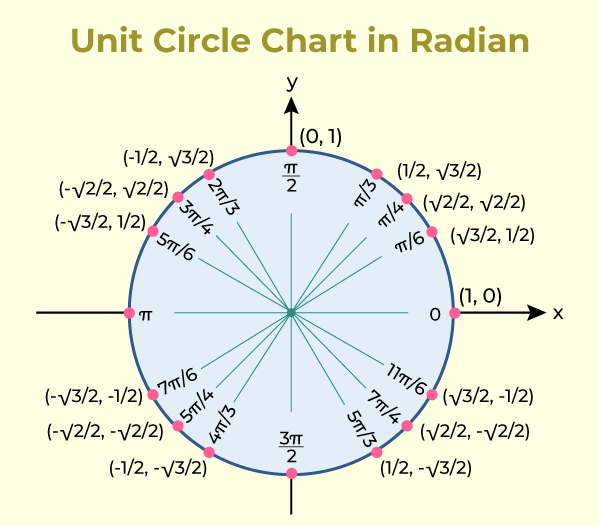
|
|
The radian is a unit of angular measure used in many areas of mathematics. One radian is defined as the angle subtended at the centre of a circle by an arc whose length is equal to the radius of the circle. It is a natural way of measuring angles and is widely used in various branches of mathematics and physics. Table of Content Definition of RadianThe angle that an arc with a length equal to the circle’s radius subtends at its centre is called a radian. Stated otherwise, the angle created at the centre is one radian if the length of the arc equals the radius. This relationship can be stated mathematically as follows:
Where,
Conversion Between Degrees and RadiansTo convert between degrees and radians, use the following relationships: Degrees to RadiansThe angular measure unit is a degree. 360 degrees is the whole revolution of a circle. In everyday situations like telling time, navigation, and basic geometry, degrees are usually utilized. Radian is additional unit of angular measure. It’s the angle that results from wrapping a circle’s radius around its perimeter. 2π radians make up a complete revolution around a circle. This is because, given a radius of r, the circumference of a circle is equal to 2πr; conversely, if the radius is 1, the circumference is equal to 2π.
Since 360 degrees equals 2π radians, we may use this to convert degrees to radians. Consequently, 1 degree is equivalent to 2π/360 = π/180
Radians to DegreesRadians to Degrees relationship can be used to convert radians to degrees: 2π radians equals 360 degrees. Consequently, 1 radian equals 360/2π 360 = 180/π degrees. An angle can be converted from radians to degrees by multiplying its radian value by 180/π.
Radian Measure of Common AnglesAlthough many mathematical applications need the conversion of angles from degrees to radians, this conversion is frequently necessary. Angles like 0°, 30°, 45°, 60°, 90°, 120°, 135°, 150°, 180°, 210°, 225°, 240°, 270°, 300°, 315°, 330°, and 360° are quite common. 180o 180ois equal to π radians, which is the connection used to convert between degrees and radians.
Using the formula:
We can determine the radian measure for each common angle using the table added below:
Radians in Trigonometric FunctionsAngles measured in radians are frequently employed with trigonometric functions like sine, cosine, and tangent. For example, the cosine and sine of an angle measured in radians correspond to the coordinates of points in the unit circle. Example: Find the sine and cosine of π/2. Solution:
Importance of Radian MeasureSince radians are closely related to the characteristics of circles, they offer an intuitive method for measuring angles. They are very helpful in calculus and higher mathematics because of this, as they simplify a lot of formulas and computations. For example, when angles are measured in radians, the derivatives and integrals of trigonometric functions become considerably easier to understand. Radians are also commonly utilized in computer science, engineering, and physics, which makes them a crucial idea for students studying these subjects. Applications of Radian MeasureRadian measure is particularly useful in various mathematical contexts, such as:
Examples on Radian MeasureExample 1: Convert 90 degrees to radians. Solution:
Example 2: Calculate the radian measure for a 75-degree angle. Solution:
Example 3: Convert -90 degrees to radians. Solution:
Example 4: What is the cosine of π radians? Solution:
Example 5: What is the angle in degrees if the radian measure is 2π? Solution:
Example 6: Find the radian measure of an angle subtended by an arc length of 10 units in a circle of radius 5 units. Solution:
Practice Problems on Radian MeasureQ1. Convert 135 degrees to radians. Q2. What is the sine of π/2. Q3. Find the radian measure of a 300-degree angle. Q4. Determine the radian measure of a 15-degree angle. Q5. Convert 720 degrees to radians. Q6. Determine the radian measure of a 30-degree angle. Q7. Find the radian measure of an angle subtended by an arc length of 20 units in a circle of radius 4 units. FAQs on Radian MeasureWhat is the Use of Radians in Trigonometric Functions?
How can Radians be Converted to Degrees?
How many Radians does a Complete Circle Measure?
Are Radians Applied in Actual World?
How is Degree Converted to Radian?
|
Reffered: https://www.geeksforgeeks.org
| Mathematics |
| Related |
|---|
| |
| |
| |
| |
| |
Type: | Geek |
Category: | Coding |
Sub Category: | Tutorial |
Uploaded by: | Admin |
Views: | 18 |
